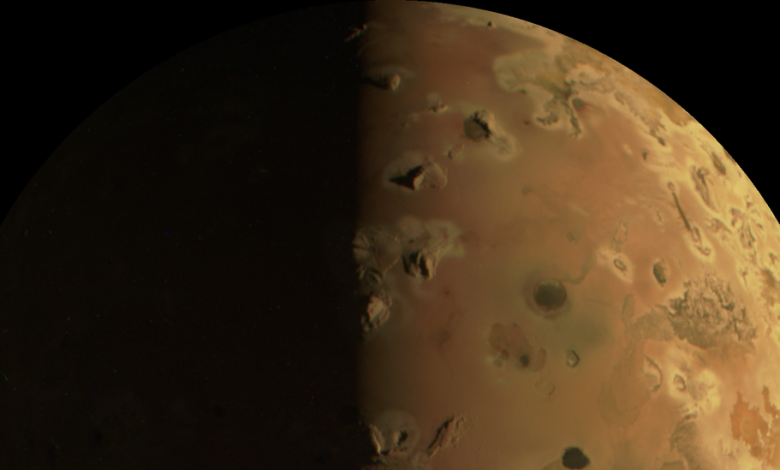New Images of Jupiter’s Moon Io Capture Infernal Volcanic Landscape

A NASA spacecraft swooped past Io, one of Jupiter’s largest moons and the most volcanically active world in our solar system. The spacecraft, the Juno orbiter, made its closest flyby yet of Io’s turbulent landscape, and sent back snapshots speckled with sharp cliffs, edgy mountain peaks, lakes of pooled lava and even a volcanic plume.
“I was in awe,” said Scott Bolton, a physicist at the Southwest Research Institute and principal investigator of the Juno mission. Dr. Bolton noted how “incredibly colorful” Io is — tinted in orangy browns and yellows because of the presence of sulfur and flowing lava. He likened the moon to a pepperoni pizza.
Studying these features can help scientists figure out what drives Io’s volcanoes, some of which shoot lava dozens of miles into space, and confirm that this activity comes from an ocean of magma hidden beneath the moon’s crust. Deciphering the secrets of the volcanoes may eventually reveal the influence Jupiter has over its eruptions, which could be a clue to how the gas giant and its satellites formed.
The Juno spacecraft, designed to study the origin and evolution of Jupiter, arrived at the planet in 2016. NASA extended the mission in 2021, and the orbiter has since captured photos of the Jovian moons Ganymede, Europa and most recently Io.
It’s not the first time a NASA spacecraft has flown by Io. In 1979, Voyager 1 discovered Io was volcanically active during its journey to interstellar space. Two decades later, NASA’s Galileo mission sent back what Dr. Bolton calls “postage stamps,” or close-ups of specific features on Io’s surface.
Juno conducted a number of more distant observations of Io in recent years. Its latest flyby occurred on Dec. 30, when the spacecraft came within 932 miles of the moon. The images captured during this visit were made with an instrument called JunoCam and are in visible wavelengths. They are some of the highest resolution views of Io’s global structure. The mission’s managers shared six images of Io on the mission’s website, and members of the public have since uploaded digitally enhanced versions that highlight features on Io’s surface.
Dr. Bolton said he was struck by the sharpness of the edges on some of the mountains in the images, which left him pondering how they get shaped and what it would be like to visit such a place.
“I wonder what it’s like to hike there,” he said, “or to snowboard off that peak.”
Mission scientists are already at work analyzing these images, searching for differences across Io’s surface to learn how often its volcanoes erupt, how bright and hot those eruptions are and how the resulting lava flows. According to Dr. Bolton, the team will also compare Juno’s images to older views of the Jovian moon to determine what has changed on Io over a variety of encounters.
And they’ll get a second set of data to work with in a month, when Juno completes another close flyby of the explosive world on Feb. 3.




